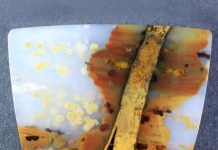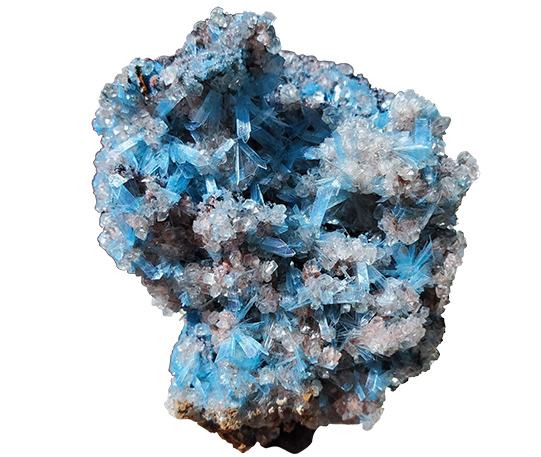
By Bob Jones
One of the unfortunate aspects of any hobby is attempts to take advantage of people’s interests for financial gain. It is inevitable that when people collect objects of interest, demand will grow and exceed supply. This fact is particularly true of minerals, as the source of any mineral species or mineral locality is by the very nature of mineral formation limited. Enter the enhanced specimens.
Like any hobby, mineral collecting suffers from those who take advantage of collectors by changing a natural mineral to make it more desirable and more saleable. They use any method to raise a mineral’s value. There are certainly well established and accepted methods for treating minerals by trimming, cleaning, and otherwise restoring a specimen to its original form and condition. This practice has been around for decades and readily accepted. But to purposely change or fake a mineral through some unnatural means that Mother Nature never intended is dishonest and unacceptable.
The latest case of such fraudulent action is a group of specimens of dyed blue hemimorphite from Mina Ojuela, Mapimi, Durango, Mexico, currently being marketed. This mining area has had an outstanding reputation for producing world-class minerals of great variety for generations. Until we know exactly what has produced these blue hemimorphites, that reputation may be impacted. The evidence is that someone is dyeing natural hemimorphite crystals a stark and vivid blue.
There is natural blue hemimorphite from some sources but no such thing as natural vivid blue hemimorphite crystals that we see today from Mina Ojuela. True, these mines have long been a ready source of lovely white crystals and pale blue massive hemimorphite or tinted by natural iron oxide or greenish malachite. But never have brilliantly colored crystals of hemimorphite in any bright blue crystal form come from this location. Of course, bright blue botryoidal hemimorphite examples have been found at many locations throughout the world. These are entirely natural. Then, suddenly, brilliant blue crystal specimens of hemimorphite appeared from Mapimi in summer 2020.
Dealers were happy to have something new and exciting as colorful minerals sell well, especially from a locality with a sturdy reputation. Dealers are, by and large, a suspicious lot, and many were cautious of this strange, new color, but evidence of authenticity, including videos of specimens being collected in situ underground, showed they were likely natural. Many dealers bought specimens for resale before the September mineral shows. Their faith proved to be misplaced as the blue hemimorphite was finally proven to be an unnaturally dyed mineral.
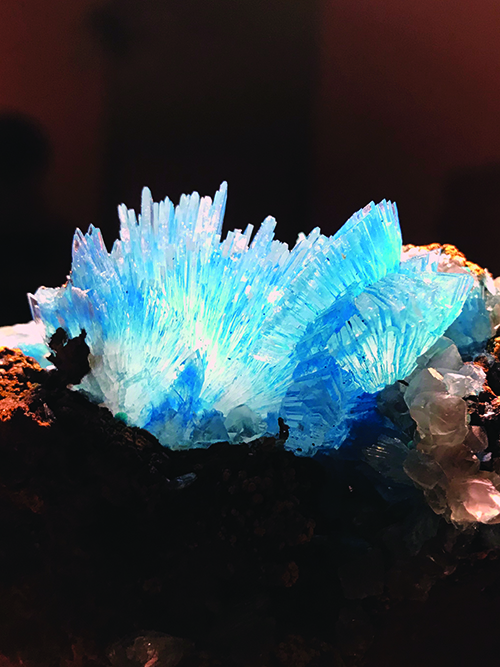
From what I have learned so far, the creation of blue hemimorphite is one of the most skillful attempts at deception ever done on a mineral. Experts have judged it to be an utterly fraudulent attempt to turn a very nice but usually colorless crystallized mineral into something of brilliant color never seen from Mapimi. Suddenly the mineral is more desirable, more valuable, and much more saleable.
It is important to note that most dealers are sincere and stand by their goods. They are also naturally suspicious based on their vast experience, which gives them an inquiring mind and the skills to recognize something out of the ordinary. Many dealers, when introduced to blue hemimorphite, did some preliminary testing of their own. The fraud was still skillful, and the specimens appeared to be natural and legitimate when initially checked. My point is, if you bought blue hemimorphite from a dealer, remember the dealer was fooled, too. By dealing with well-known reputable dealers, you are less apt to have problems.
Whoever was responsible for the blue hemimorphite fakes was very smart. By making a video of the minerals in place, they had evidence of authenticity. I do not know how this was done, but it shows intent on pulling off a successful con job.
The first blue hemimorphite specimens appeared in this country sometime in August of 2020. The latest information I’ve received reports the specimens had also been sold in large quantities to dealers in Europe, Africa, and beyond. Imagine what this will do to a dealer who has invested if, as most experts now say, it is proven to be fraudulent goods. We can be grateful that in 2020 most shows had been canceled, making it less easy to flood the specimen market with this apparent fraud. As it is, the stuff is now all over the place. Thankfully, the scam was revealed early enough before much lasting damage was done.
Fake specimens showed up in some quantity at the shows held in Denver in September 2020. Many dealers already had plenty of specimens at this point in the year, and it appears some had invested considerable sums in this fake mineral. My son Evan bought a small lot to test the market and sold a few in Denver, since early testing and physical examination of specimens suggested they were completely natural and significant new mineral discovery. Many dealers conducted tests with positive results. For example, the mystery blue mineral was seemingly impervious to most known solvents and simple testing. One interesting note is a trace of copper had shown up in initial analytical testing. Copper is a well-known blue coloring agent in minerals, so this tended to confirm the blue mineral was probably legit.
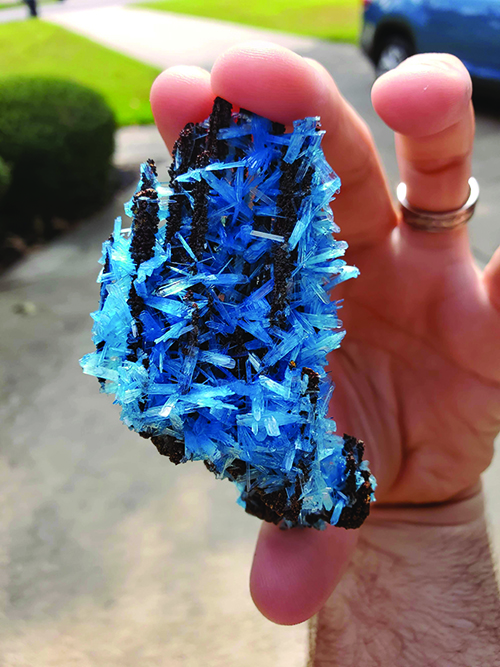
Finally, one dealer sent specimens to Dr. John Rakovan of Miami University, Oxford, Ohio, to check on these blue strangers. Dr. Rakovan did some preliminary testing with inconclusive results but then did more in-depth testing using Raman Spectroscopy, and this finally revealed the truth. The blue material was a dye that is almost impossible to detect and which is extremely colorfast. This result means ordinary analysis would not dislodge it or reveal its presence. Plus, the specimens’ physical characteristics appeared perfectly natural and explainable, such as blue hemimorphite crystals with snow-white calcite crystals. How was this selective dyeing done? The testing by Dr. Rakovan finally revealed the culprit. What was used is a synthetic blue pigment, called Phthalocyanine Blue BN, an organic dye. This dye is not easy to remove because it is stable, which explains why ordinary chemical tests showed nothing unusual.
Putting this fake mineral on the market has resulted in all sorts of consequences. Some dealers who bought these fakes in quantity have lost a lot of money, which they will have difficulty recovering, if ever. This scam has undoubtedly hurt their business as well. The customers who bought these fakes in good conscience have also been fooled.
Thank goodness the vast majority of retail mineral dealers stand behind their sales, so any specimen returned by them will be honored with an immediate return of their money. Evan honored his sales as soon as he knew the truth.
Another consequence has to do with Mapimi specimen reputation and the miners who make a living off their collecting efforts. Most miners and dealers in Mexico are honest. But the general feeling is that some miners and dealers had to have been involved in this scam, which reflects poorly on the good reputation of the honest Mapimi miners and mineral dealers.
This is certainly not the first-time fakes have appeared in our hobby. It has happened repeatedly, though the blue hemimorphite is the most blatant attempt to fake a specimen for gain. I can think of other instances when someone has fiddled with minerals to enhance them and pass them off as natural, but the depth and sophistication of this scam is at a different level entirely.
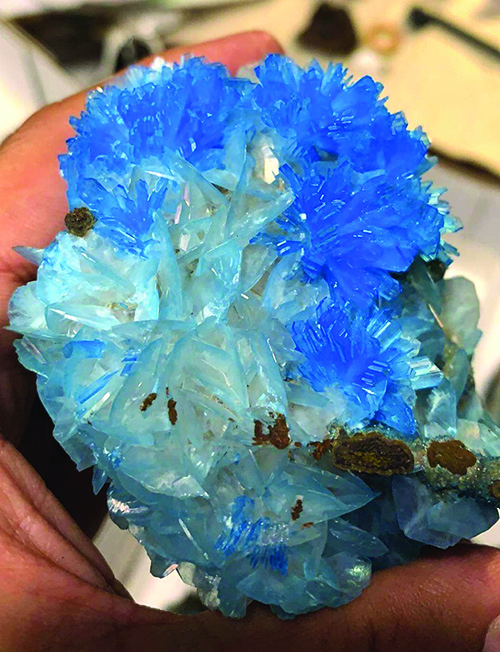
You are all very familiar with the wonderful water clear colorless quartz specimens from the Hot Springs area in Arkansas. Fine, clear, colorless quartz from this location has been mined for centuries. Even the local natives used quartz to make sharp points for their weapons. I’ve collected in the area, and the one thing you don’t find when digging at Hot Springs is smoky quartz. It just does not occur there. Another fake was sulfur crystals grown on specimens from the sulfur mines of Sicily!
A few decades ago, dealers and collectors were very surprised when smoky quartz from Arkansas showed up in Tucson. The crystals were a quite deep smoky color. Plenty of dealers and collectors were suspicious but were assured everything was natural. But the secret didn’t stay secret long. It was revealed the quartz had been treated with, guess what, radiation.
The problem with fakes and fraudulently treated minerals is they do not disappear from the market after the fraud is discovered. They may stay in a collection for decades, then suddenly appear, and no one is the wiser.
Another practice to be aware of is to raise the value of a specimen by crediting it to someplace it didn’t originate. Mineral labels are the history of a specimen and are essential. I’ve seen a few examples of an old label being put with a less valuable specimen from some common location and offered for sale as a classic specimen.
One former dealer who I knew did this with an old label of mine. He is no longer in business, as folks figured him out.
The lesson in all this is twofold. Knowledge is the most valuable commodity you can collect. As your understanding grows, you can enlarge your field of interest and be less susceptible to dishonesty. Talk to knowledgeable people, other collectors, and especially dealers, and ask questions. Handle as many minerals as possible to enlarge your scope of mineral knowledge.
Also, talk to museum curators and dealers at shows — study museum collections to learn what is good, classic, and important. You will soon begin to recognize the good dealers who want to teach and share their knowledge. If you can visit with collectors whose exhibits you like, they are willing to share their knowledge. That’s how our knowledge grows. The American Federation of Mineralogical Societies has an expression that we should all practice: Each One Teach One. Gaining knowledge from other, more experienced collectors, and joining a good, active mineral club, will help you grow in the hobby and be less apt to be fooled.
By immersing yourself in the hobby, you will develop a sixth sense about minerals and will be less likely to fall victim to someone who is in the hobby for selfish reasons. We are part of the world’s greatest hobby, which can give you a lifetime of pleasure. Just stay away from the blue hemimorphite specimens of the hobby.
(Specimen information and photos courtesy of Evan Jones)
Author: Bob Jones
 Holds the Carnegie Mineralogical Award, is a member of the Rockhound Hall of Fame, and has been writing for Rock & Gem since its inception. He lectures about minerals, and has written several books and video scripts.
Holds the Carnegie Mineralogical Award, is a member of the Rockhound Hall of Fame, and has been writing for Rock & Gem since its inception. He lectures about minerals, and has written several books and video scripts.
If you enjoyed what you’ve read here we invite you to consider signing up for the FREE Rock & Gem weekly newsletter. Learn more>>>
In addition, we invite you to consider subscribing to Rock & Gem magazine. The cost for a one-year U.S. subscription (12 issues) is $29.95. Learn more >>>




